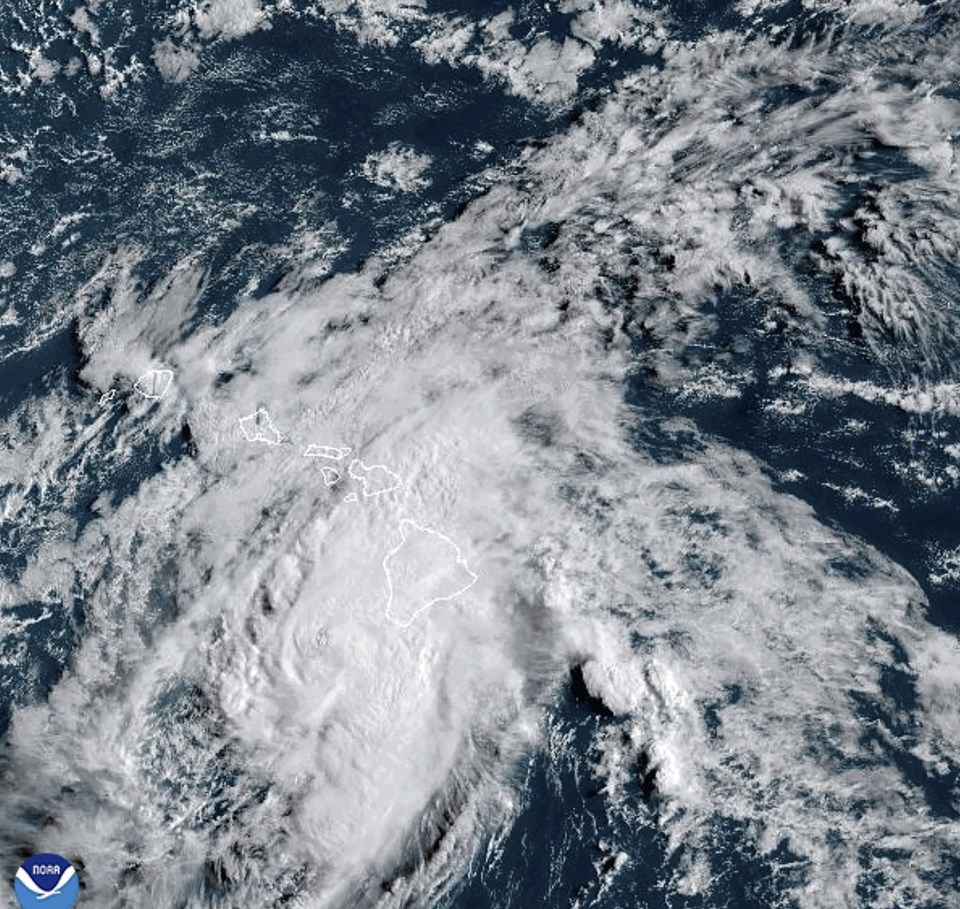HONOLULU (AP) — Hone was swirling past Hawaii's main islands on Monday, after it weakened to a tropical storm the day before, and blasted the Big Island with rain.
Meanwhile, in the eastern Pacific, Tropical Storm Hector gained strength, packing top sustained winds of 50 mph (about 80 kph). There were no coastal watches or warnings in effect as Hector was still churning far out at sea, the National Hurricane Center said.
Hone (pronounced hoe-NEH) had top winds of 65 mph (110 kph) Monday morning as it moved past Hawaii about 240 miles (386 kilometers) southwest of Honolulu and 205 miles (about 330 kilometers) south of Lihue, according to a 5 a.m. advisory from the Central Pacific Hurricane Center.
William Ahue, a forecaster at the center in Honolulu, said the biggest impacts from Hone were rainfall and flash floods that resulted in road closures, downed power lines and damaged trees in some areas.
Julia Neal, the owner of a bed-and-breakfast located on a former sugar plantation in Pahala, on the Big Island, said she and some guests were “experiencing tropical storm winds and heavy pounding rain through the night.” She added that “Hone was also a gift in a way because we have been experiencing a lot of drought.”
On Sunday, floods closed Highway 11 between Kona and Hilo, and a higher-altitude alternative, the Cane Road, was closed by flooding as well, isolating properties like the Aikane Plantation Coffee Co. outside Pahala, where owner Phil Becker said his 10-inch (25-centimeter) rain gauge overflowed in the deluge.
“We’ve got quite a lot of flood damage, the gulches are running full speed ahead and they’re overflowing the bridges, so we’re trapped down here, we can’t get in or out,” Becker said.
Becker said his plantation is off the grid, powered with batteries charged by solar electricity, and his family is safe, so they have no reason to evacuate. The weather may even prove beneficial: “We’ve been in a drought situation so the coffee is probably loving all this rain,” he said.
Hurricane Gilma, meanwhile, which was still far east of Hawaii, gained a bit of strength on Monday morning. Gilma is expected to remain a hurricane through Tuesday, but was forecast to weaken considerably before it reaches the islands. As of early Monday, Gilma was about 1,220 miles (1,963 kilometers) east of Hilo with top winds of 105 mph (169 mph).
Shelters were opened over the weekend as Hone blew in and beach parks on the eastern side of the Big Island were closed due to dangerously high surf, Hawaii County Mayor Mitch Roth said.
Hone, whose name is Hawaiian for “sweet and soft,” poked at memories still fresh of last year's deadly blazes on Maui, which were fueled by hurricane-force winds. Red flag alerts are issued when warm temperatures, very low humidity and stronger winds combine to raise fire dangers. Most of the archipelago is already abnormally dry or in drought, according to the U.S. Drought Monitor.
The Aug. 8, 2023, blaze that torched the historic town of Lahaina was the deadliest U.S. wildfire in more than a century, with 102 dead. Dry, overgrown grasses and drought helped spread the fire.
The cause of the Lahaina blaze is still under investigation, but it’s possible it was ignited by bare electrical wire and leaning power poles toppled by the strong winds. The state’s two power companies, Hawaiian Electric and the Kauai Island Utility Cooperative, were prepared to shut off power if necessary to reduce the chance that live, damaged power lines could start fires, but they later said the safety measures would not be necessary as Hone blew past the islands.
___
Walker reported from New York.
Jennifer Sinco Kelleher And Julie Walker, The Associated Press




